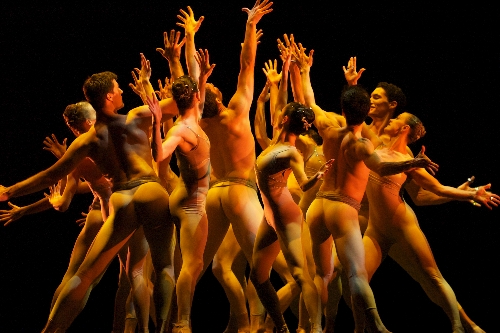Joffrey Ballet blending past, present, art, accessibility

Hitting the road’s nothing new for the Joffrey Ballet.
After all, the troupe’s first tour, in 1956, featured six dancers, a borrowed station wagon, a U-Haul trailer packed with costumes – and an itinerary that took them to small-town theaters and school gymnasiums.
But the company (the focus of director Robert Altman’s 2003 movie “The Company”) has traveled miles, and worlds, since then.
And on Tuesday and Wednesday, the Joffrey’s road leads to The Smith Center’s Reynolds Hall.
At both performances, the company will perform a reconstructed version of “Le Sacre du Printemps ” (better known to some as “The Rite of Spring”), which sparked riots – not to mention the modern music and dance movements – when it premiered in Paris a century ago.
Preceding “Sacre” on Tuesday’s program: choreographer (and former Joffrey dancer) William Forsythe’s angular, athletic “In the Middle, Somewhat Elevated” (originally commissioned by Rudolf Nureyev for the Paris Opera Ballet in 1987); and choreographer Edwaard Liang’s Jane Austen-inspired “The Age of Innocence,” in which dancers assemble in formal ballroom fashion before pairing off for ardent duets danced to music by Philip Glass and Thomas Newman.
Leading off Wednesday’s program: the new work “Son of Chamber Symphony,” choreographed by Stanton Welch, the Houston Ballet’s artistic director, to the music of John Adams; and “After the Rain,” three sensual duets choreographed by Christopher Wheeldon to Arvo Part’s “Spiegel im Spiegel (Mirror in Mirror).”
The settings and dances may be different, but they share one thing: an artistic vision that melds past and present, art and accessibility.
That’s as it should be, says Ashley Wheater , the Joffrey Ballet’s artistic director, in a telephone interview from Chicago, which became the company’s headquarters in 1995. (The Joffrey Ballet School remains in New York City, the troupe’s original home base.)
Wheater’s only the third person to lead the celebrated troupe – following Robert Joffrey himself and the troupe’s co-founder, Gerald Arpino .
Having danced for both Joffrey (who died in 1988) and Arpino (who died in 2007), Wheater knows the company – and its philosophy – well.
“You want to honor works from the past and show what the company is today,” he explains.
Both Smith Center programs do just that.
Besides being the centennial of “Sacre’s” groundbreaking debut, it’s the 25th anniversary of the Joffrey’s 1987 re-creation, the result of more than a decade of research by husband-and-wife collaborators Millicent Hodson and Kenneth Archer, who tracked down original scores, paintings, reviews, notes and first-person recollections to re-create the landmark work.
Wheater described the process as “piecemealing it back together” to give subsequent audiences “the closest idea as to what the original audience saw.”
And that, he explains, was something “quite primal” – and “a whole new way of collaborating,” with Ballets Russes founder Serge Diaghilev orchestrating a production that merged Igor Stravinsky’s instant-classic score with legendary dancer Vaslav Nijinsky’s striking choreography, which depicts a ritual tribal sacrifice.
The choreography also requires the dancers to move in a way that counters years of training, Wheater notes.
“We spend years rotating our legs” outward, he observes, “and here it’s all clenched fists and stomping on the ground – the opposite of what we try to achieve every day.”
Although the Joffrey company brought its “Sacre” to New York and Washington, D.C., following its 1987 debut, “for a lot of America, they haven’t seen this,” he notes. Unless, of course, they caught the “Dance in America” broadcast on PBS back in 1990. (The Joffrey returned to PBS last month when “American Masters” presented the documentary “Joffrey: Mavericks of American Dance.”)
As for the other dances planned for The Smith Center tour stop, “whatever you do, it’s going to be a big departure from ‘Sacre,’ ” Wheater says, only partially in jest.
The Joffrey’s diversity of dances, and dancers, reflects not only the company’s range but its founder’s artistic principles, says James Canfield, Nevada Ballet Theatre’s artistic director – who, like Wheater, danced with company.
“Mr. Joffrey was the true visionary,” Canfield says, noting that the company’s namesake was referred to as the “Johnny Appleseed of dance” because he made dance accessible for the masses, planting the seeds for dance companies that later sprang up across America.
“Something people could relate to,” Canfield says, “that’s what his legacy is.”
Along with the desire to resurrect almost-lost works from early in the 20th century – and discover choreographers of the future.
“I always said that Robert Joffrey was the American Serge Diaghilev,” Wheater notes, citing Joffrey’s support for promising choreographers – including Twyla Tharp, who burst onto the scene with 1973’s “Deuce Coupe,” a ballet-modern dance fusion featuring Beach Boys tunes.
But rock music was nothing new for the Joffrey, whose founder created the multimedia rock ballet “Astarte ” in 1967 – which wound up on the cover of Time magazine.
“He was never afraid to try something new,” Wheater says.
That philosophy set the Joffrey Ballet apart from America’s two other leading New York-based ballet companies, in Canfield’s view.
American Ballet Theatre specialized in “big, big ballets,” Canfield says, with big star names to match, from Baryshnikov to Nureyev. (Not to mention Cynthia Gregory, who is now NBT’s artistic coach.) New York City Ballet, meanwhile, focused on the choreography of such legends as George Balanchine and Jerome Robbins.
“Mr. Joffrey was everything else,” Canfield says, noting “the masterpieces, the vault of repertoire” that reflected “the history of dance worldwide,” augmented by new works.
“He was a risk-taker – and he trusted his dancers,” says Canfield, noting that the troupe’s two Las Vegas programs provide “great examples of Ashley (Wheater) keeping the torch lit.”
And, of course, keeping the Joffrey Ballet on the road.
“We’ve started to do a lot of touring,” Wheater explains, partly to showcase “a new generation of dancers – and a new generation of choreographers,” thereby enabling new audiences to see how “great ‘In the Middle’ is.”
The dancers themselves also have attracted plenty of praise, such as this assessment from Boston Globe critic Janine Parker: “The company boasts so many terrific dancers that it seems unfair not to mention them all, especially given the Joffrey’s non-ranking system; but suffice to say, wow.”
In Wheater’s view, it’s “an eclectic company that is not afraid to take on anything.”
As a result, Joffrey audiences say, “ ’I want to go see the Joffrey, because I know they will show me something that’s going to enlighten me,’ ” Wheater suggests.
Something that shows them “how broad the art form is,” that “it’s not just pointe shoes and tutus,” he says. “People have an assumption that ballet is stuck in the 19th century. But the Joffrey was about the 20th century – and now it’s about the 21st.”
Contact reporter Carol Cling at ccling@reviewjournal.com or 702-383-0272.
PreviewJoffrey Ballet
7:30 p.m. Tuesday and Wednesday
Reynolds Hall, The Smith Center for the Performing Arts, 361 Symphony Park Ave.
$22-$102 (749-2000, www.thesmithcenter.com)


















